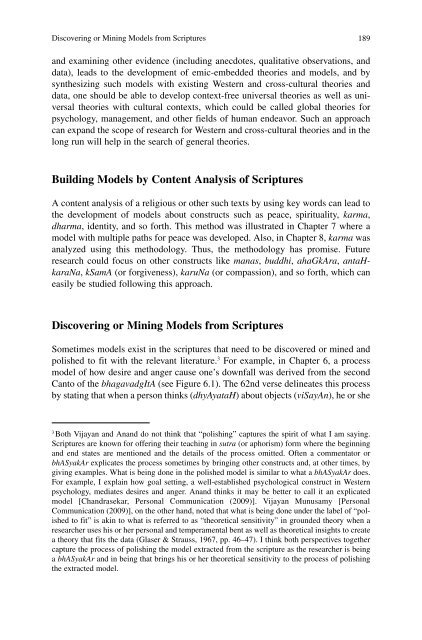Spirituality and Indian Psychology: Lessons from ... - Mandhata Global
Spirituality and Indian Psychology: Lessons from ... - Mandhata Global
Spirituality and Indian Psychology: Lessons from ... - Mandhata Global
Create successful ePaper yourself
Turn your PDF publications into a flip-book with our unique Google optimized e-Paper software.
Discovering or Mining Models <strong>from</strong> Scriptures<br />
<strong>and</strong> examining other evidence (including anecdotes, qualitative observations, <strong>and</strong><br />
data), leads to the development of emic-embedded theories <strong>and</strong> models, <strong>and</strong> by<br />
synthesizing such models with existing Western <strong>and</strong> cross-cultural theories <strong>and</strong><br />
data, one should be able to develop context-free universal theories as well as universal<br />
theories with cultural contexts, which could be called global theories for<br />
psychology, management, <strong>and</strong> other fields of human endeavor. Such an approach<br />
can exp<strong>and</strong> the scope of research for Western <strong>and</strong> cross-cultural theories <strong>and</strong> in the<br />
long run will help in the search of general theories.<br />
Building Models by Content Analysis of Scriptures<br />
A content analysis of a religious or other such texts by using key words can lead to<br />
the development of models about constructs such as peace, spirituality, karma,<br />
dharma, identity, <strong>and</strong> so forth. This method was illustrated in Chapter 7 where a<br />
model with multiple paths for peace was developed. Also, in Chapter 8, karma was<br />
analyzed using this methodology. Thus, the methodology has promise. Future<br />
research could focus on other constructs like manas, buddhi, ahaGkAra, antaHkaraNa,<br />
kSamA (or forgiveness), karuNa (or compassion), <strong>and</strong> so forth, which can<br />
easily be studied following this approach.<br />
Discovering or Mining Models <strong>from</strong> Scriptures<br />
Sometimes models exist in the scriptures that need to be discovered or mined <strong>and</strong><br />
polished to fit with the relevant literature. 3 For example, in Chapter 6, a process<br />
model of how desire <strong>and</strong> anger cause one’s downfall was derived <strong>from</strong> the second<br />
Canto of the bhagavadgItA (see Figure 6.1). The 62nd verse delineates this process<br />
by stating that when a person thinks (dhyAyataH) about objects (viSayAn), he or she<br />
3 Both Vijayan <strong>and</strong> An<strong>and</strong> do not think that “polishing” captures the spirit of what I am saying.<br />
Scriptures are known for offering their teaching in sutra (or aphorism) form where the beginning<br />
<strong>and</strong> end states are mentioned <strong>and</strong> the details of the process omitted. Often a commentator or<br />
bhASyakAr explicates the process sometimes by bringing other constructs <strong>and</strong>, at other times, by<br />
giving examples. What is being done in the polished model is similar to what a bhASyakAr does.<br />
For example, I explain how goal setting, a well-established psychological construct in Western<br />
psychology, mediates desires <strong>and</strong> anger. An<strong>and</strong> thinks it may be better to call it an explicated<br />
model [Ch<strong>and</strong>rasekar, Personal Communication (2009)]. Vijayan Munusamy [Personal<br />
Communication (2009)], on the other h<strong>and</strong>, noted that what is being done under the label of “polished<br />
to fit” is akin to what is referred to as “theoretical sensitivity” in grounded theory when a<br />
researcher uses his or her personal <strong>and</strong> temperamental bent as well as theoretical insights to create<br />
a theory that fits the data (Glaser & Strauss, 1967, pp. 46–47). I think both perspectives together<br />
capture the process of polishing the model extracted <strong>from</strong> the scripture as the researcher is being<br />
a bhASyakAr <strong>and</strong> in being that brings his or her theoretical sensitivity to the process of polishing<br />
the extracted model.<br />
189

















